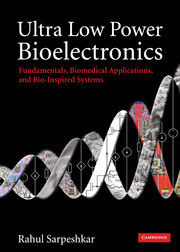Book contents
- Frontmatter
- Contents
- Acknowledgements
- Section I Foundations
- 1 The big picture
- 2 Feedback systems: fundamentals, benefits, and root-locus analysis
- 3 MOS device physics: general treatment
- 4 MOS device physics: practical treatment
- 5 MOS device physics: small-signal operation
- 6 Deep submicron effects in MOS transistors
- 7 Noise in devices
- 8 Noise in electrical and non-electrical circuits
- 9 Feedback systems
- 10 Return-ratio analysis
- Section II Low-power analog and biomedical circuits
- Section III Low-power RF and energy-harvesting circuits for biomedical systems
- Section IV Biomedical electronic systems
- Section V Principles for ultra-low-power analog and digital design
- Section VI Bio-inspired systems
- Section VII Energy sources
- Bibliography
- Index
- Epilogue
- References
1 - The big picture
from Section I - Foundations
Published online by Cambridge University Press: 02 December 2010
- Frontmatter
- Contents
- Acknowledgements
- Section I Foundations
- 1 The big picture
- 2 Feedback systems: fundamentals, benefits, and root-locus analysis
- 3 MOS device physics: general treatment
- 4 MOS device physics: practical treatment
- 5 MOS device physics: small-signal operation
- 6 Deep submicron effects in MOS transistors
- 7 Noise in devices
- 8 Noise in electrical and non-electrical circuits
- 9 Feedback systems
- 10 Return-ratio analysis
- Section II Low-power analog and biomedical circuits
- Section III Low-power RF and energy-harvesting circuits for biomedical systems
- Section IV Biomedical electronic systems
- Section V Principles for ultra-low-power analog and digital design
- Section VI Bio-inspired systems
- Section VII Energy sources
- Bibliography
- Index
- Epilogue
- References
Summary
It is the harmony of the diverse parts, their symmetry, their happy balance; in a word it is all that introduces order, all that gives unity, that permits us to see clearly and to comprehend at once both the ensemble and the details.
It is through science that we prove, but through intuition that we discover.
Henri PoincaréThis book, Ultra Low Power Bioelectronics, is about ultra-low-power electronics, bioelectronics, and the synergy between these two fields. On the one hand it discusses how to architect robust ultra-low-power electronics with applications in implantable, noninvasive, wireless, sensing, and stimulating biomedical systems. On the other hand, it discusses how bio-inspired architectures from neurobiology and cell biology can revolutionize low-power, mixed-signal, and radio-frequency (RF) electronics design. The first ten chapters span feedback systems, transistor device physics, noise, and circuit-analysis techniques to provide a foundation upon which the book builds. Chapters that describe ultra-low-power building-block circuits that are useful in biomedical electronics expand on this foundational material, followed by chapters that describe the utilization of these circuits in implantable (invasive) and noninvasive medical systems. Some of these systems include cochlear implants for the deaf, brain implants for the blind and paralyzed, cardiac devices for noninvasive medical monitoring, and biomolecular sensing systems. Chapters that discuss fundamental principles for ultra-low-power digital, analog, and mixed-signal design unify and integrate common themes woven throughout the book. These principles for ultra-low-power design naturally progress to a discussion of systems that exemplify these principles most strongly, namely biological systems.
- Type
- Chapter
- Information
- Ultra Low Power BioelectronicsFundamentals, Biomedical Applications, and Bio-Inspired Systems, pp. 3 - 27Publisher: Cambridge University PressPrint publication year: 2010
References
- 1
- Cited by



